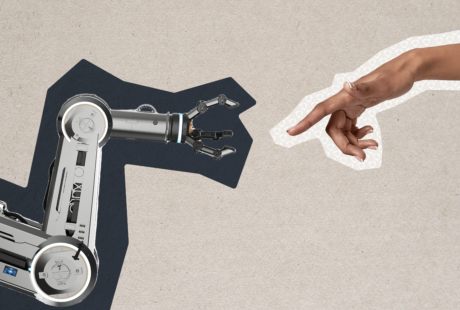Related:
Construction Tech During COVID-19 and Beyond
The future of construction is here, and massive building projects are being completed by robots and laptops. Sort of. The truth is that the construction industry still relies on the contributions of good old fashioned humans, even as the roles played by those quaint flesh and bone machines continuously evolve. Tech is transforming the sector, causing progressive construction companies to advance their recruitment and training programs in step.
The Construction Revolution Will Be Digitized
“Necessity is the mother of invention,” writes Eilis McCann for Method. “With labor shortages and shrinking profits, tech in the construction industry promises increased productivity, efficiency, and safety.”1
It’s a promise that’s coming to fruition. Jobsite automation is alleviating the pressure on hard-to-come-by labourers. 3D printing is revolutionizing materials and components. Building information modelling (BIM), construction management software (CMS), and data analysis are informing decision making and project management. Drones are mapping areas and providing site security. Smart contracts use blockchain technology to track workflow and purchases. Green buildings and smart cities are revolutionizing the way we live, while challenging the imaginations of engineers and construction professionals alike. Even protective equipment has entered the future, with wearable technology and augmented reality being used to spot and mitigate potential danger.
“After a turbulent period of adjusting forecasts and changing expectations, 2022 will be a year of re-emergence and growth in the construction industry,” predicts BigRentz. “Rising construction costs and labor shortages persist, challenging the industry to innovate competitive new ideas, while stricter regulations contribute to a reduced margin for error and waste.”2
Humans: Replaced or Revamped?
With available labour posing a challenge to the industry, autonomous construction equipment is being seen as a good investment.
“The fact that robots are replacing monotonous, labor-intensive jobs has opened up space for humans to take over more specialized positions,” writes Emma Ludman for Chicago Agent magazine.3
BigRentz agrees, “More accurately than “replacing” humans, these robots are changing the jobs humans do — in most cases, they’re augmenting human decision-making (like deciphering and translating data findings into actionable insights) and making room for different, higher-level jobs.”2
3D printing offers a prime example of a disruptive technology that requires human expertise.
“With the proper technological advances and regulatory adjustments, it’s entirely possible that a number of years down the line, the most important person on the jobsite will be the one who understands how to communicate the project design plans to the printer,” proclaims ViaTechnik.4
Training for Tomorrow’s Construction Industry
Benefits enjoyed by companies that offer robust training and development opportunities to their staff are twofold. Not only will these efforts ensure that their team is able to maintain competitive advantages with regards to innovative practices, but such opportunities also serve as a boon to recruitment and retention efforts, particularly with regards to ambitious and tech savvy talent.
A ‘Future Skills Report’ released in 2019 by the UK’s Construction Leadership Council forecasts continuing advancements in modular construction, automation, and digital technology, necessitating ongoing efforts to keep pace. The report calls digital training ‘integral’ and says that “technicians must be multi-skilled and able to operate in a variety of different environments.”5
Leon Quinn, CEO of Balfour Beatty Construction describes the current landscape as nothing less than a ‘digital revolution’, adding, “These changes will mean we have to ensure our industry trains our current and future employees with the skills to exploit the use of new technology, new materials and new methods of working.”3
Recruiting Women and Gen Z in Construction
The pandemic has exacerbated talent gaps in the industry by both prompting retirements and complicating training efforts. As a result, the recruitment of tech talent remains top of mind. Women, long under-represented in the industry, will be a big part of the solution. Although gains have been made, plenty of room still exists to increase the role of females in construction.
In order to attract young talent, the construction industry will need to convince Generation Z that it’s a fitting home for their interests and skill sets. Showcasing the technical nature of the industry will go a long way towards persuading these so-called ‘digital natives’ to pursue a career in construction. Fortunately attitudes toward trade schools are improving, with many seeing it as a viable pathway to a secure, vital, and well-compensated career.
Of course construction does not stand alone amongst industries attempting to entice tech-savvy talent with promises of innovation and progress. The industry has always been known for hard-workers, but will have to allow for work-life balance if it hopes to compete for a generation’s brightest. Doing so will not only position companies to survive in the short term, but to thrive in a competitive, innovative future.
Cited Sources
1 McCann, Eilis. “Key Trends in the Construction Industry for 2022.” Method, July 2, 2021. https://www.method.me/blog/how-to-get-ahead-of-construction-industry-trends/.
2 BigRentz, Inc. “Bigrentz.” BigRentz, December 13, 2021. https://www.bigrentz.com/blog/construction-trends.
3 “Robots Expected to Overtake Humans in Construction by 2025 – Chicago Agent Magazine New Construction.” Chicago Agent Magazine, December 23, 2019. https://chicagoagentmagazine.com/2019/12/24/robots-expected-to-overtake-humans-in-construction-by-2025/.
4 “How Far Away Is Construction’s Automated Future?” VIATechnik, October 20, 2020. https://www.viatechnik.com/how-far-away-is-constructions-automated-future/.
5 “2020 And beyond: Required Skills for the Future of Construction.” iTWO costX, December 20, 2019. https://www.itwocostx.com/company/blog/2020-and-beyond-required-skills-for-the-future-of-construction/.




